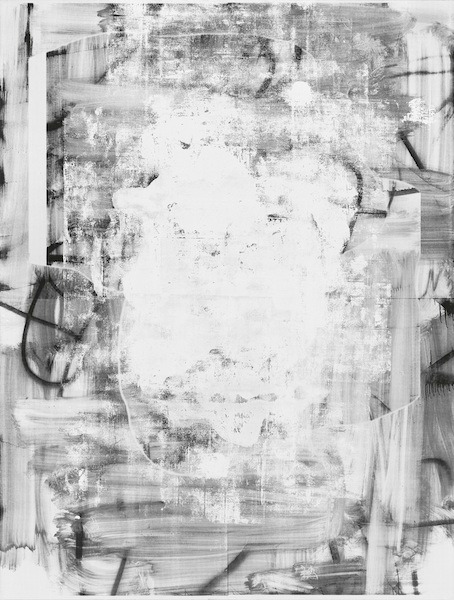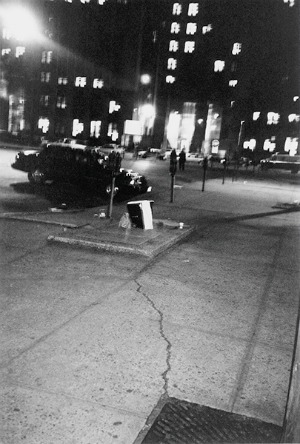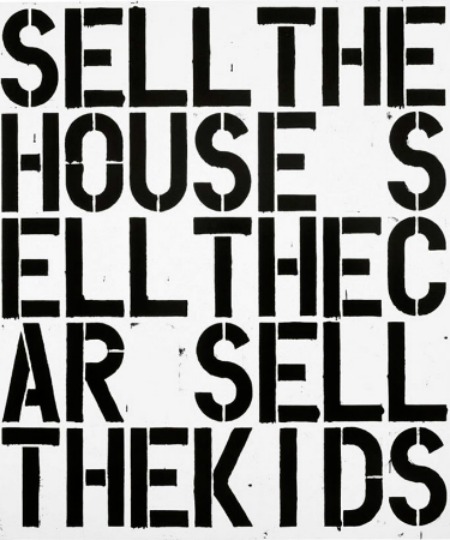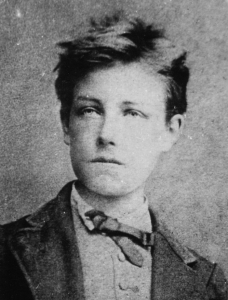Christopher Wool gets better in this century. The Guggenheim retrospective (through Jan. 22) proves it. The words and wallpaper-roller and black-on-white sprayed, printed and tricked-up paintings of the last century all have their place, but the 21st-century “gray paintings” are so far his best. Less sarcastic. More complicated. More subtle. More ironic.
I look upon his 20th-century paintings, even the word paintings, as rehearsals for the gray paintings. No more offhand appropriations of graffiti and Pattern Painting. Just erasures and smears. Spray-enamel loops smudged with solvent. Gloomy layers, like smoke or dust from the World Trade Center towers, long ago.
And there are black-and-white photos, too. These intermissions or sidebars seem to puzzle everyone but me. Some show the dark side of the artist’s walks from the East Village to his studio in Chinatown. Is that dark side in his paintings? He clearly picked up words in capitals and lanky spray-can lines from the graffiti he saw. In regard to the words, everyone quotes the artist to the effect that his spotting of UV SEX LUV spray-canned on a truck yielded his first word painting: LUV SEX LUV.
Alas, the most famous word painting, Apocalypse Now (1988) [SELL THE HOUSE SELL THECAR SELL THE KIDS] ), had been put up for auction and was not available for the retrospective at the Guggenheim. Instead, it sold for $26.5 million.
- Apocalypse Now, 1988.
And when people began to cover up and clean off tags, did those cloudy smears get stuck in Wool’s head too as inspirations for his gray paintings?
The artist now lives part-time in Marfa, Texas, which has become quite an artist colony, if you can avoid the Donald Judd monument to himself — which, I am told, casts a spell over all. Will Wool’s art change? I am always interested in how environment influences art, aren’t you? What you see every day feeds your brain. That is why living in boring places kills all art. As for myself, I am Ernest in town and Jack in the country. And didn’t de Kooning lighten up when he settled in East Hampton?
The Guggenheim spiral ramp offers a judicious LINK survey of Wool’s work, from bottom to top, apparently with the artist’s help. Usually that’s a sign of weak curatorial practice, but in this case it seems to have worked. There are no rules. Some artists know their own best work, and others, alas, do not. I could tell you stories, but not quite yet.
Another Intermission: Motherwell
By happenstance we are also treated to (on Annex Level 4) a show of Robert Motherwell’s early collages done from 1941-1951, when the young and ever-so-wealthy editor of the seminal anthology Dada Painters and Poets was still enthralled by his Surrealist buddy Matta. Just so you know, Motherwell’s father was the president of the Wells Fargo Bank.
I confess I have never really liked Motherwell’s much-acclaimed “Elegies to the Spanish Republic.” Of course, we are anti-Franco, but it turns out that the collages are so much better than the “Elegies.” How can this be? Perhaps the small scale and the use of paper and glue was less intimidating than paint on canvas
The Elegies always look to me like blow-ups of something else. I thought perhaps of studies and preparatory drawings. Maybe Motherwell had secretly violated the Ab-Ex principle of ad hoc painting? But no, it is merely that he could not translate what he had accomplished in the early collages into real paintings. Most of his paintings are hesitant, though some are insouciant. The distance between these two adjectives is enormous. How can you be insouciant about the Spanish Civil War, or after reading Hemingway?
The Elegies are never quite convincing. The collages are solid. So you see it is not just recently that we are confronted with the phenomenon of the early bloomer not able to surpass first efforts.
In art there are no Rimbauds. Rimbaud, the miraculous French poet, burned out like a shooting star at the age of 20 and never wrote another poem. In art, we want long-distance runners. Painters are never allowed to escape to Africa and live the life of adventurers, which is what Rimbaud did before dying of cancer of the leg at 37. The value of moving to Tahiti has long worn out.
More Wool-Gathering
The gray paintings hint that in Wool we may have our long-awaited long-distance runner. They are about fear. This and the colorless pallet – blacks, whites, grays — form a language that grows out of the earlier, more sarcastic work that is now so popular with collectors.
Is the fear a fear of expression or a fear of inauthenticity? Or even of authenticity? I doubt that it is the weak fear generated by those self-serving academics who were in favor of “pictures” rather than paintings. The Artformalists insisted that by 1984, painting had painted itself into a corner. That was hogwash. Painting was Crimped and Kraused in service of weakly conceptual pictures, about which distance does not make the heart grow fonder. True, some artists transcended the category, but many have now been left in the dustbin of “art history” as … not quite distanced enough.
In contrast, Wool’s gray paintings are so distanced that they make Warhol seem like van Gogh. Warhol’s technique of silk-screening found that photo images on canvas in the long run made the images more emotional, as liquid sloppily applied tends to do. The photo images were emotionalized, even though poet Gerard Malanga or a number of others did the actual silk-screening. I myself was witness to Andy “finishing” a bunch of silkscreen paintings on the floor of the Factory. He kicked them here and there with his foot, to give that personal, handmade touch, that unexpected irregularity, that little bit of added value.
Wool’s smeared-solvent erasures are more closely linked to Lichtenstein’s painted cartoon-splashes rather than Warhol’s grungy, improper registrations. Some have compared Wool’s erasures to Robert Rauschenberg’s famous erased de Kooning drawing. The difference is that Wool is erasing himself. And it is not nearly half the fun.
What is he hiding?
The layering, erasures and blockages engage the eye and induce what a painter friend of mine calls “ocular excavation” — a taboo aspect of Abstract Expressionism.
Yet in Wool there is an archeology of surfaces — but, alas, not of the soul. The paradox, I suppose, is that self-effacement has produced, on the surface, some highly decorative abstract paintings, but ones that do not photograph all that well. I tried to find some images that matched my experience, my memory. None. Zero. You have to be there. You have to see them in real life to understand what is happening.
Will this be one of the characteristics of 21st-century painting, that it is camera-proof, rather than camera-approved? We all knew last century that if your work was not photogenic, it did not exist. When and if camera-proof art replaces camera-approved art, how will grants be awarded to painters who make camera-proof art? How will that art be communicated to the public, to collectors, to art historians?
In terms of Wool’s gray paintings, somebody had to do them. Somebody had to denature both Ab-Ex and Pop, leaving a new world wherein painting would once again be allowed to have meaning.
Assignment: If you removed Wool’s printing, rubber-stamping, erasures, overlays and other strategies of distancing, what would you have left? Nothing! The distancing is the meaning.
John Perreault is on Facebook. Links here for John Perreault website & John Perreault’s art.





